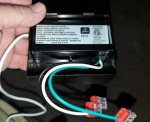wwhitney
Senior Member
- Location
- Berkeley, CA
- Occupation
- Retired
The one in your picture has the color temperature selection switch on the j-box. I think that means the driver is in the j-box.
Cheers, Wayne
Cheers, Wayne

